英汉基本色彩词文化内涵比较及翻译(英文翻译)
- 格式:doc
- 大小:80.00 KB
- 文档页数:15
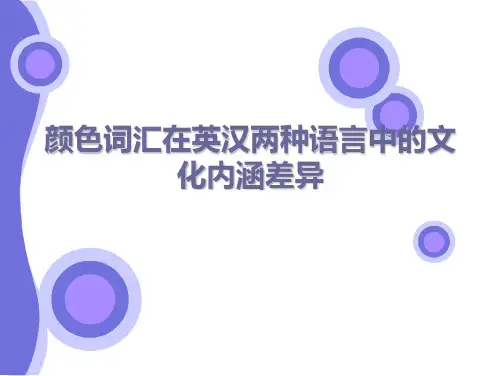
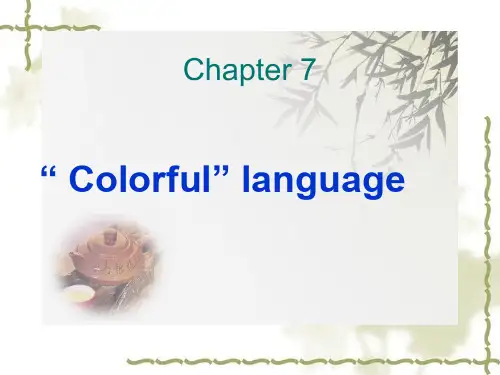
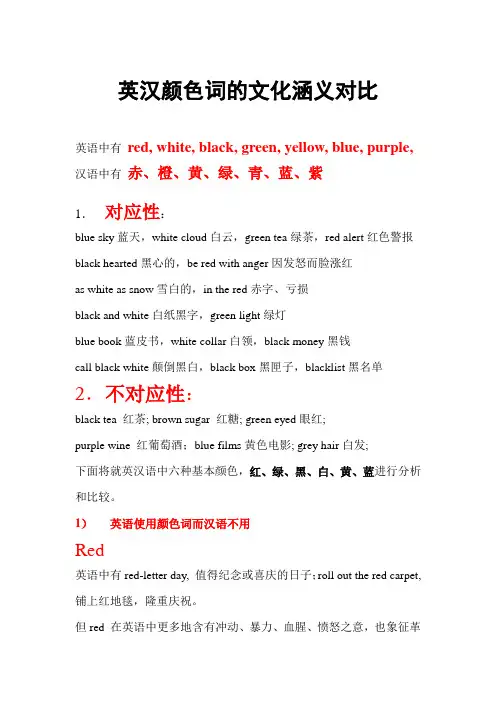
英汉颜色词的文化涵义对比英语中有red, white, black, green, yellow, blue, purple, 汉语中有赤、橙、黄、绿、青、蓝、紫1.对应性:blue sky蓝天,white cloud白云,green tea绿茶,red alert红色警报black hearted黑心的,be red with anger因发怒而脸涨红as white as snow雪白的,in the red赤字、亏损black and white白纸黑字,green light绿灯blue book蓝皮书,white collar白领,black money黑钱call black white颠倒黑白,black box黑匣子,blacklist黑名单2.不对应性:black tea 红茶; brown sugar 红糖; green eyed眼红;purple wine 红葡萄酒;blue films黄色电影; grey hair白发;下面将就英汉语中六种基本颜色,红、绿、黑、白、黄、蓝进行分析和比较。
1)英语使用颜色词而汉语不用Red英语中有red-letter day, 值得纪念或喜庆的日子;roll out the red carpet, 铺上红地毯,隆重庆祝。
但red 在英语中更多地含有冲动、暴力、血腥、愤怒之意,也象征革命,但多含贬义,如,red battle 血战;red revenge 血腥的复仇; red-necked 极度好战的; red hot political campaign激烈的政治运动;He is a red-handed man. 他是个双手沾满血腥的人。
GreenGreen: 绿色的象征意义同青绿的草木颜色有很大的联系,在英语中象征着生机勃勃、青春、活力,也可表示嫉妒、眼红,如,green house 温室; green hand 新手; green with envy 嫉妒;green old age 老当益壮; keep the memory green永远不忘;另外,美国的钞票为绿色,因此常用green 代表钞票、钱财或有经济实力的,如,green back美钞;green power金钱的力量或财团;green sheet 政府预算明细表;中国传统文化中,绿色代表侠义、野蛮,如绿林好汉泛指聚集山林,劫富济贫的人。
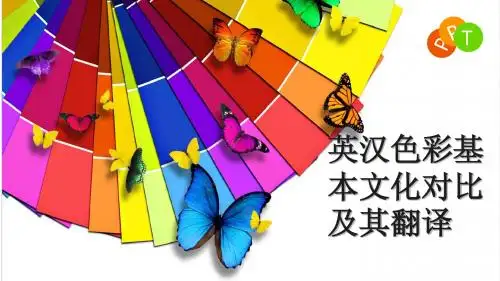
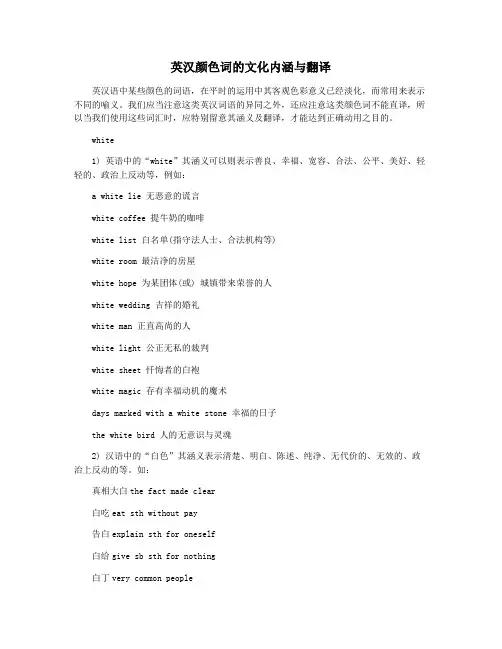
英汉颜色词的文化内涵与翻译英汉语中某些颜色的词语,在平时的运用中其客观色彩意义已经淡化,而常用来表示不同的喻义。
我们应当注意这类英汉词语的异同之外,还应注意这类颜色词不能直译,所以当我们使用这些词汇时,应特别留意其涵义及翻译,才能达到正确动用之目的。
white1) 英语中的“white”其涵义可以则表示善良、幸福、宽容、合法、公平、美好、轻轻的、政治上反动等,例如:a white lie 无恶意的谎言white coffee 提牛奶的咖啡white list 白名单(指守法人士、合法机构等)white room 最洁净的房屋white hope 为某团体(或) 城镇带来荣誉的人white wedding 吉祥的婚礼white man 正直高尚的人white light 公正无私的裁判white sheet 忏悔者的白袍white magic 存有幸福动机的魔术days marked with a white stone 幸福的日子the white bird 人的无意识与灵魂2) 汉语中的“白色”其涵义表示清楚、明白、陈述、纯净、无代价的、无效的、政治上反动的等。
如:真相大白the fact made clear白吃eat sth without pay告白explain sth for oneself白给give sb sth for nothing白丁very common people白眼the tired look不分皂白not tell right or wrong白痴the foolish person白圭之玷之心the good man’s shortcominggreen1) 英语中的green 一词可以则表示代莱、年长的、妒忌的、佳境的等。
例如:a green hand 新手green house 暖房green room 演员休息室as green as grass 并无生活经验的green eyed monster 嫉妒green fingers 顺利的种植者;栽种的高超技艺green thumb 园芝技能green light 绿灯获准许可green line (军) 轰炸机、敌我分界线green stuff 蔬菜草木in the green 青春期a green old age 老当益壮to get the green light 得到允许做某事to look through green glasses 对..深感妒忌jack in the greens 花屋中的人(西俗五月一日用冬青和花扎成小屋,人居其中,上街)in the green tree (或wood) 处在佳境green power (美) 金钱的力量green sand(铸成用的) 崭新挑砂go to the green wood 落草(去当绿林好汉)2) 汉语中的“青色”还可以则表示年长的、代莱、未成熟的、强壮的、永恒的等。
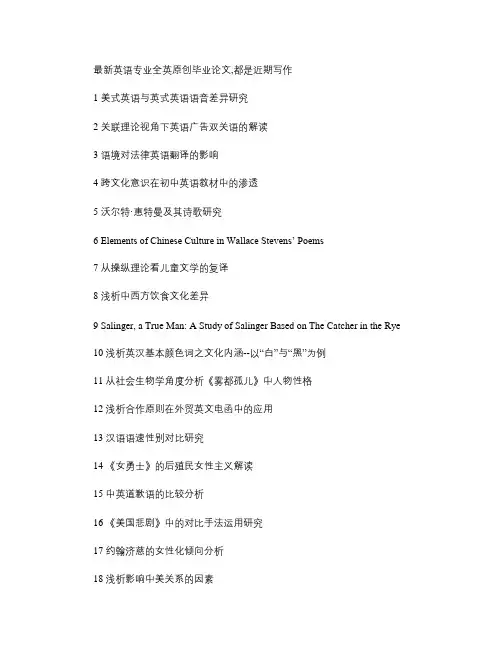
最新英语专业全英原创毕业论文,都是近期写作1 美式英语与英式英语语音差异研究2 关联理论视角下英语广告双关语的解读3 语境对法律英语翻译的影响4 跨文化意识在初中英语教材中的渗透5 沃尔特·惠特曼及其诗歌研究6 Elements of Chinese Culture in Wallace Stevens’ Poems7 从操纵理论看儿童文学的复译8 浅析中西方饮食文化差异9 Salinger, a True Man: A Study of Salinger Based on The Catcher in the Rye10 浅析英汉基本颜色词之文化内涵--以“白”与“黑”为例11 从社会生物学角度分析《雾都孤儿》中人物性格12 浅析合作原则在外贸英文电函中的应用13 汉语语速性别对比研究14 《女勇士》的后殖民女性主义解读15 中英道歉语的比较分析16 《美国悲剧》中的对比手法运用研究17 约翰济慈的女性化倾向分析18 浅析影响中美关系的因素19 试论《出狱》中“房子”的意象20 《喜福会》中的女性身份重建21 对比分析英式英语和美式英语的区别22 解析名词化与商务语篇的汉英翻译23 徒劳的追求——对《宠儿》中黑尔的悲剧分析24 论性别歧视25 《夜莺颂》的翻译技巧探究26 关于数字在英语商务合同中的应用的讨论27 初中英语教学中开展游戏的积极作用28 《祝福》两个英译本翻译中文化缺失现象的对比研究29 Advertising Translation from a German Functionalist Approach30 从麦当劳看美国快餐文化31 浅谈商务英语合同的翻译32 商务英语中模糊限制语的语用学研究33 Differences Between English and Chinese Euphemisms and Influences on Cross-cultural Communication34 侦探小说的发展35 The Theme of Absurdity in The Scarlet Letter36 A Study of Nonverbal Communication37 语用策略在英语商务信函中的应用38 从跨文化角度对商标翻译的研究39 解读《儿子与情人》中保罗的俄狄浦斯的影响40 Comparison of Color Words between Chinese and English Culture41 分析戴珍珠耳环的少女42 Maintaining and Revitalizing the Native American Languages43 A Summary of Symbols of The Scarlet Letter44 非英语专业大学生英语学习动机调查45 从《简•爱》的多译本看中国两性关系的变化46 浅谈中国电影字幕英译中的归化与异化47 从习语翻译看文化空缺48 语义翻译与交际翻译在英语专业八级翻译考试中的应用49 背诵在中学英语学习中的作用50 爱恨共辉煌——浅析《呼啸山庄》中的男主人公51 做最好的自己—论斯佳丽形象对现代女性的教育意义52 《安尼尔的鬼魂》中“鬼魂”的象征意义探究53 A Study of Translation of Chinese Idioms with Numeral “San”54 改变,选择与责任——论电影《猜火车》中的青少年成长55 从写作方法分析《宠儿》的主题56 《动物农场》中隐喻的应用及其政治讽刺作用57 从文体学角度分析《海狼》两个译本58 中西方婚礼礼服颜色的对比研究59 广告英语修辞特点及其翻译60 Modern Views on Marriages in Wuthering Heights61 英汉数词的文化对比及其翻译62 探析《愤怒的葡萄》中人性的力量63 英语新闻的用词和翻译64 英语姓名的文化内涵65 从美国总统就职演说看美国文化价值观66 “雨中的猫”与“一个小时的故事”中女性意识觉醒的比较研究67 《麦克白》的独白68 哈代的女性观在苔丝中的反映69 广告语篇的语用分析70 On the Linguistic Characteristics of the Constitution of the United States and Its Translation Skills71 裘德悲剧成因的分析72 目的论视角下新闻标题汉译英研究73 从公示语的语言特色谈其翻译74 红河州农村英语学习两极分化75 《卖花女》中莉莎人物形象分析76 从高中生生理和心理的角度探讨PPT使用的利弊77 浅析《小妇人》中乔的女性意识及其成长过程78 A Study o f Chinglish as Found in Students’ Writings79 论《老人与海》所表现的人与自然的关系80 《愤怒的葡萄》中的圣经原型81 从跨文化视角解析商标名称翻译82 旅游宣传品的翻译83 英语新闻标题的文体特点与翻译84 英汉基本颜色词文化内涵对比85 浅析英汉颜色词的文化内涵及翻译86 中英日委婉语语言特征87 跨文化交际中的文化心理准备分析88 汉民族节日名称英译中的文化价值取向研究89 An Analysis of David’ s Dual Pe r sonality in David Copperfield90 从《一间自己的房间》看弗吉尼亚•伍尔夫的女性主义91 Western and Chinese Marriage Differences in Cross-cultural Communication9293 《本杰明•富兰克林自传》和《嘉莉妹妹》美国梦的对比研究94 解析电影《黑暗骑士》中的美国个人英雄主义95 从《撞车》谈种族主义对美国黑人的影响96 跨文化交际中非语言沟通的文化差异性研究97 (英语系经贸英语浅析企业如何通过市场定位打开销售渠道98 小说《飘》中瑞德巴特勒的人物性格分析99 Cultural Differences Between English and Chinese by Analyzing Brand Names100 全身反应教学法在儿童英语教学中的运用101 英语语义歧义分析及其语用价值102 An Analysis of Verbal Humor in American Sitcom Friends from the Perspective of Cooperative Principal103 《藻海无边》中边缘女性的生存与救赎104 《呼啸山庄》中哥特式风格的表现105 简•奥斯丁的女权主义在《理智与情感》中的体现106 从文化角度看中美家庭教育的差异107 从原型批评理论观点看《红字》的圣经原型108 中美大学生课堂讨论话语性别差异对比109 从《所罗门之歌》中主人公的心路历程看美国黑人成长110 On Hybridization in Translation of Culture-loaded Lexemes in Moment in PekingThe Duality of Life and Death——An Analysis on Virginia Woolf’s Mrs. Dalloway111 浅谈《鲁滨逊漂流记》中现实主义元素112 师生关系与学生英语学习积极性之关联性探析113 The Differences of Nonverbal Languages between China and the West114 分析埃里森《隐形人》中美国的种族歧视115 观春潮:浅析“戏仿”背后海明威性格阴暗面116 理想与现实的距离——《麦田里的守望者》中主人公霍尔顿的求索之路117 产品说明书的翻译技巧118 受超验主义影响的具有美国精神的作家119 An Analysis of the Tragic Fate of Mary Turner in The Grass Is Singing120 概念隐喻视角下的美剧《复仇》的语篇分析121 浅谈英语“根据”表达法122 浅谈中西体态语的差异123 非传统式英雄——从女性主义批评角度看《名利场》124 论《西游记》中文化因素的翻译策略——以詹纳尔和余国藩的英译本为例125 英语定语从句的理解与翻译126 从黑人女性主义解读《宠儿》中塞丝的觉醒127 论英语被动语态的语篇功能及其翻译策略—以《高级英语》第二册为例128 《药》的两个英译本中翻译技巧比较129 An Analysis of the D Film Alice in Wonderland from the Perspective of Gothicism 130 Exploring The Matrix: Hacker Metaphysics131 中西方饮食文化比较研究132 英语外贸电子邮件的语篇分析133 浅谈英语复杂句的翻译134 《宠儿》的非线性叙事模式135 英汉委婉语的文化对比研究——以“死亡”委婉语为例136 论旅游广告的显影性137 汉英翻译中的中国式英语产生的原因及对策138 教师在农村初中英语游戏教学中的角色分析--以某中学为例139 Study on Characteristics of American Black English from Social Perspectives 140 从《一个干净明亮的地方》和《老人与海》看虚无主义中的抗争及其发展141 《红字》中对自由的求索142 礼貌原则在英语商务信函中的运用143 中国皮钦语的产生和发展144 对《觉醒》的女权主义解读145 文明的樊笼—解读《野性的呼唤》146 凯特•肖邦小说《觉醒》中的超验主义思想分析147 中西方酒类广告的文化互文性研究148 从魔幻现实主义角度解读《百年孤独》中的象征色彩149 论文化对词语内涵意义的影响150 浅析商务谈判中非言语交际的核心地位151 从主角与配角之间关系的角度探讨《老人与海》中的生存主题152 永不凋落的玫瑰—从女性主义分析《红字》中的海斯特153 论AIDA模式在大众汽车英文广告中的语言体现154 A CP-based Analysis of Humor in Friends155 广告英语中双关语的翻译156 浅析《睡谷传奇》中的浪漫主义157 美国梦的幻灭——论《推销员之死》158 命运与社会的牺牲品—苔丝的悲剧根源探析159 试析海明威《丧钟为谁而鸣》中的人物形象160 浅谈在华跨国公司的本土化策略161 论《觉醒》中艾德娜女性意识的觉醒162 教师在英语自主学习中的作用163 二元对立模型在伍尔夫《达洛卫夫人》中的应用164 从道德角度分析简•奥斯丁《劝导》中的女主人公安妮•艾略特165 《老人与海》中圣地亚哥的人物性格分析166 从人性论分析维克多•雨果的《悲惨世界》167 谈电影片名汉译的不忠168 汉语公示语英译中存在的问题及分析169 Cultural Difference between Chinese and American Advertisement170 论杰里米·边沁的功利主义171 Transcendentalism in Thoreau's Walden172 《嘉莉妹妹》中的自然主义173 An Analysis of Snobbery in Jane Austen’s Pride and Prejudice, Sense and Sensibility, and Mansfield Park174 广告对中国百姓生活的影响175 英文商业广告中的常用修辞格--以《商业周刊》为例176 目的论在公司宣传广告英译中的应用177 《沙漠之花》的女性主义研究178 一个纯洁的女人的毁灭—苔丝的悲剧性色彩浅析179 从女性主义角度看《觉醒》中爱德娜的女性主体意识觉醒180 《了不起的盖茨比》中的象征手法181 《红字》中海斯特性格分析182 中英文新闻标题的差异183 中西方饮食文化的比较研究184 对《斯佳丽》中生态女权主义的解读185 论《小伙子古德曼布朗》中象征主义的使用186 《莫比.迪克》中的象征意义187 对英文广告中模糊语言美学功能的理论探究188 中法餐桌文化对比189 从目的论看《红楼梦》中“狗”习语的翻译190 从生态主义观解读《愤怒的葡萄》191 浅析英语习语的翻译原则和方法192 论马可•吐温小说中的讽刺技巧193 中西方饮料的跨文化差异194 商标翻译分析195 论《最蓝的眼睛》中的黑人文化传统196 《威尼斯商人》中的种族及宗教冲突197 广告英语及其翻译198 浅谈英汉文化差异对称呼语的影响199 英汉基本颜色词的文化内涵对比及其翻译200 中美商务接待文化差异。
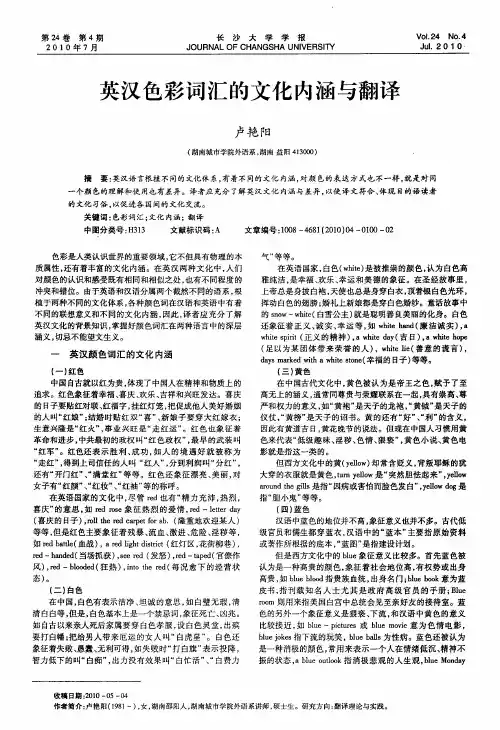

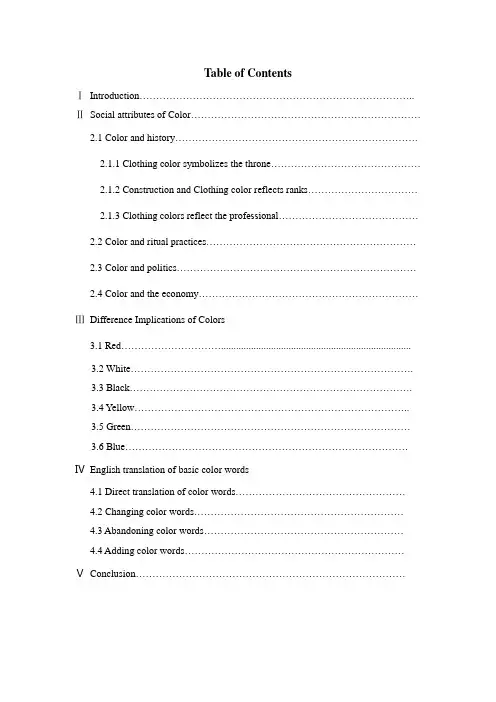
Table of ContentsⅠIntroduction……………………………………………………………………….. ⅡSocial attributes of Color……………………………………………………………2.1 Color and history……………………………………………………………….2.1.1 Clothing color symbolizes the throne………………………………………2.1.2 Construction and Clothing color reflects ranks……………………………2.1.3 Clothing colors reflect the professional……………………………………2.2 Color and ritual practices………………………………………………………2.3 Color and politics………………………………………………………………2.4 Color and the economy…………………………………………………………ⅢDifference Implications of Colors3.1 Red…………………………............................................................................3.2 White………………………………………………………………………….3.3 Black………………………………………………………………………….3.4 Y ellow………………………………………………………………………..3.5 Green…………………………………………………………………………3.6 Blue…………………………………………………………………………. ⅣEnglish translation of basic color words4.1 Direct translation of color words……………………………………………4.2 Changing color words………………………………………………………4.3 Abandoning color words……………………………………………………4.4 Adding color words…………………………………………………………ⅤConclusion………………………………………………………………………AbstractWord which is to express the color with each national language in the world is different and also has different classification. The classification about basic color words in Chinese-english nation is basically alike as using seven divided method which means red, orange, yellow, green, cyan, blue, violet. Translating those words related to the amount of basic color in English and Chinese language correctly, the key is to grasp these color words cultural connotation. This article discusses the general rules of the color words translation and generalizes the four basic translations by comparing the chinese and english basic color words in cultural conotation.Key words Basic color words; Connotative meaning; cultural connotation; translationCultural differences between China and the west as revealedin color words and their translationⅠIntroductionThe boundless universe is full of all the colors of the rainbow. Sunrise of the east, the bright moonlight, cerulean sea, green fields, the golden waves of the wheat,the place to thrive and grow and the foundation of the development of civilization is provided by the flowery and profuse human nature.There are abundant color words in English and Chinese languages. The color words form a special word group which is a subsystem in their vocabulary system.English and Chinese color words can be divided into two categories, namely basic color words and real color words. The basic color words are those specifically used for showing the colors of the objects, such as black, white, red, yellow, green, blue, purple in English.汉语中的黑、白、红、黄、绿、蓝、紫。
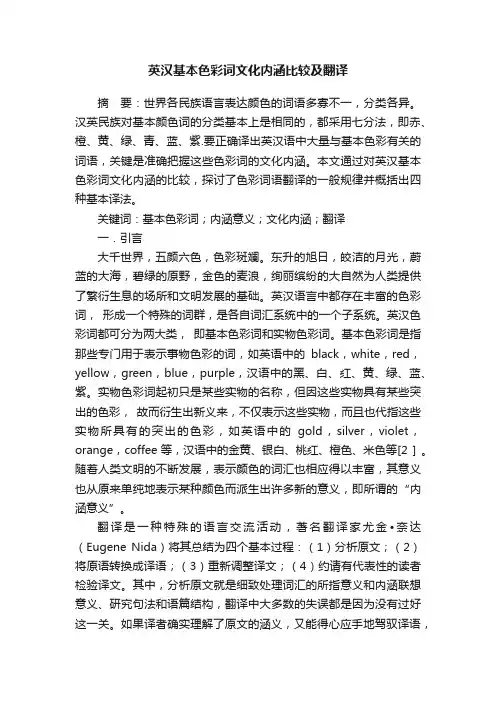
英汉基本色彩词文化内涵比较及翻译摘要:世界各民族语言表达颜色的词语多寡不一,分类各异。
汉英民族对基本颜色词的分类基本上是相同的,都采用七分法,即赤、橙、黄、绿、青、蓝、紫.要正确译出英汉语中大量与基本色彩有关的词语,关键是准确把握这些色彩词的文化内涵。
本文通过对英汉基本色彩词文化内涵的比较,探讨了色彩词语翻译的一般规律并概括出四种基本译法。
关键词:基本色彩词;内涵意义;文化内涵;翻译一.引言大千世界,五颜六色,色彩斑斓。
东升的旭日,皎洁的月光,蔚蓝的大海,碧绿的原野,金色的麦浪,绚丽缤纷的大自然为人类提供了繁衍生息的场所和文明发展的基础。
英汉语言中都存在丰富的色彩词,形成一个特殊的词群,是各自词汇系统中的一个子系统。
英汉色彩词都可分为两大类,即基本色彩词和实物色彩词。
基本色彩词是指那些专门用于表示事物色彩的词,如英语中的black,white,red,yellow,green,blue,purple,汉语中的黑、白、红、黄、绿、蓝、紫。
实物色彩词起初只是某些实物的名称,但因这些实物具有某些突出的色彩,故而衍生出新义来,不仅表示这些实物,而且也代指这些实物所具有的突出的色彩,如英语中的gold,silver,violet,orange,coffee等,汉语中的金黄、银白、桃红、橙色、米色等[2 ] 。
随着人类文明的不断发展,表示颜色的词汇也相应得以丰富,其意义也从原来单纯地表示某种颜色而派生出许多新的意义,即所谓的“内涵意义”。
翻译是一种特殊的语言交流活动,著名翻译家尤金•奈达(Eugene Nida)将其总结为四个基本过程:(1)分析原文;(2)将原语转换成译语;(3)重新调整译文;(4)约请有代表性的读者检验译文。
其中,分析原文就是细致处理词汇的所指意义和内涵联想意义、研究句法和语篇结构,翻译中大多数的失误都是因为没有过好这一关。
如果译者确实理解了原文的涵义,又能得心应手地驾驭译语,翻译就是一个很自然的驾轻就熟的过程[3 ] 。
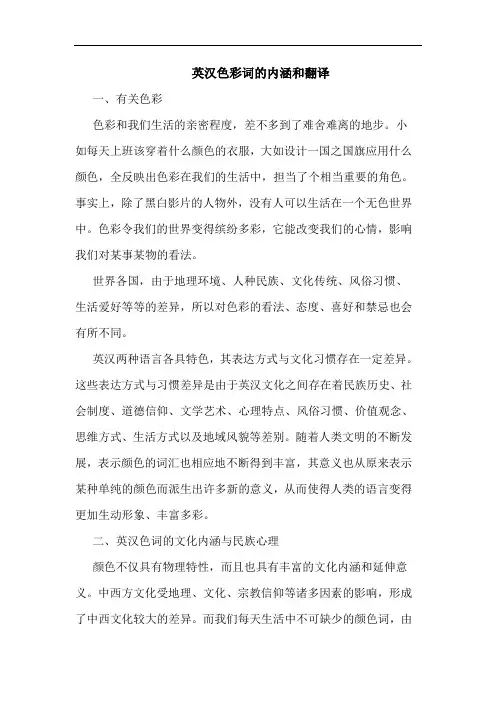
英汉色彩词的内涵和翻译一、有关色彩色彩和我们生活的亲密程度,差不多到了难舍难离的地步。
小如每天上班该穿着什么颜色的衣服,大如设计一国之国旗应用什么颜色,全反映出色彩在我们的生活中,担当了个相当重要的角色。
事实上,除了黑白影片的人物外,没有人可以生活在一个无色世界中。
色彩令我们的世界变得缤纷多彩,它能改变我们的心情,影响我们对某事某物的看法。
世界各国,由于地理环境、人种民族、文化传统、风俗习惯、生活爱好等等的差异,所以对色彩的看法、态度、喜好和禁忌也会有所不同。
英汉两种语言各具特色,其表达方式与文化习惯存在一定差异。
这些表达方式与习惯差异是由于英汉文化之间存在着民族历史、社会制度、道德信仰、文学艺术、心理特点、风俗习惯、价值观念、思维方式、生活方式以及地域风貌等差别。
随着人类文明的不断发展,表示颜色的词汇也相应地不断得到丰富,其意义也从原来表示某种单纯的颜色而派生出许多新的意义,从而使得人类的语言变得更加生动形象、丰富多彩。
二、英汉色词的文化内涵与民族心理颜色不仅具有物理特性,而且也具有丰富的文化内涵和延伸意义。
中西方文化受地理、文化、宗教信仰等诸多因素的影响,形成了中西文化较大的差异。
而我们每天生活中不可缺少的颜色词,由于中西方的分类不同和特定的社会文化背景所赋予的附加意义和引申意义,以及特定的文化群体对其所指事物所怀的感想和所抱的态度的差异,因此产生了特定的文化意义。
所以,当我们在翻译这些带有颜色词的表达方式时,一定要弄清它的实际含义。
有时,这些颜色词并不表示颜色,而是其它引申意义或其它内涵,这时就转变成了其它特殊的含义。
下面就七种颜色词分别举例略作说明。
1. 红色 red红色是自然界中最普遍的一种颜色。
无论是在中国还是在讲英语的国家,红色总是表示幸福、节日和胜利的意思。
在中国,我们把red叫做“红色,朱色”,红色代表吉祥和幸运或高兴。
红色是中华民族最喜爱的颜色,甚至成为中国人的文化图腾和精神皈依。
Translation of Color Words颜色词的意义:指称意义,文化意义红色:●汉民族最喜爱的颜色之一。
是太阳和火的颜色。
对于汉民族来说, 太阳和火可以给人们带来光明和温暖, 所以人们自古以来就偏好用红色来象征幸福, 喜庆, 欢乐和热烈。
古代中国人对红色极为崇尚, 达官贵人的住宅被成为“朱门”, 他们穿着“朱衣”, 就有了那句名诗“朱门酒肉臭, 路有冻死骨。
”汉民族结婚要有红色的喜字, 新娘要穿大红衣服, 过年的时候要在门口贴红底黑字的对联。
汉语中的有红的词语通常是褒义的, 如“红火”, “开门红”, “红颜”, “走红”, 等等。
在中国, 红色还象征着革命和社会主义。
一系列的词都表现了这种含义, 如“五星红旗”, “红军”, “红领巾”, “红色政权”, 等等。
●红白喜事weddings and funerals●红榜honor roll●红心loyal heart●红得发紫extremely popular●走红运to have a good luck●红利bonus●大红人 a favorite with sb. in power在英语中, 红色也可以表达喜庆的意思, 但红色还有一定的贬义, 表示潜在的危险, 极端的热情, 政治上的极端等含义。
如: red flag(红旗), 中国人看来是高尚崇高的东西, 而在英语中, 这意味着铁道上有危险, 从而逐渐引申为“使人生气的东西”。
再如英语中的red lights district(红灯区), 则是指色情场所。
●red alert , (台风,空袭)紧急警报●the red carpet 隆重的欢迎●red battle 一场血战●red ruin 火灾●red-eye whisky 廉价的威士忌酒●red box 英国大臣用的文件匣●red herring:转移人们注意力的东西。
白色在汉民族文化中对黑白都有禁忌, 在汉语中, 白除了有“纯洁”的含义外, 多是贬义, 常常与死亡, 不幸和不吉利联系在一起,如“白事”(丧事)。
英汉颜色词的文化内涵及其翻译颜色词在不同文化中具有不同的内涵和象征意义。
以下是一些常见的颜色词及其文化内涵和翻译。
1. 红色(Red):文化内涵:红色在中国文化中象征吉祥、喜庆和热情。
它常被用于庆祝节日和婚礼,也代表着幸福和好运。
另一方面,在西方文化中,红色通常与爱、激情和力量相关联。
翻译:Red例句:- 中国春节期间,人们会戴红色的衣物和饰品。
(During Chinese New Year, people wear red clothes and accessories.)- 红色玫瑰象征着爱情和浪漫。
(Red roses symbolize love and romance.)2. 黄色(Yellow):文化内涵:在中国文化中,黄色代表着皇室的权力和地位,也象征着丰收和富裕。
另一方面,在西方文化中,黄色通常与快乐、温暖和活力相关联。
翻译:Yellow例句:- 中国传统文化中,黄色是皇家的颜色。
(In traditionalChinese culture, yellow is the color of royalty.)- 这个房间的墙壁涂成了明亮的黄色。
(The walls of this room are painted in a bright yellow color.)3. 蓝色(Blue):文化内涵:蓝色在西方文化中通常被视为冷静、平静和信任的象征。
它也与水和天空相关联。
在中国文化中,蓝色通常与生气勃勃和健康相关联。
翻译:Blue例句:- 我喜欢在晴朗的天空下看蓝色的海洋。
(I love looking at the blue ocean under a clear sky.)- 这个房间的墙壁漆成了深蓝色,给人一种宁静的感觉。
(The walls of this room are painted in a deep blue color, givinga sense of tranquility.)4. 绿色(Green):文化内涵:绿色在许多文化中都被视为生命、自然和希望的象征。
英汉基本色彩词文化内涵比较及翻译(一)摘要:世界各民族语言表达颜色的词语多寡不一,分类各异。
汉英民族对基本颜色词的分类基本上是相同的,都采用七分法,即赤、橙、黄、绿、青、蓝、紫.要正确译出英汉语中大量与基本色彩有关的词语,关键是准确把握这些色彩词的文化内涵。
本文通过对英汉基本色彩词文化内涵的比较,探讨了色彩词语翻译的一般规律并概括出四种基本译法。
论文关键词:基本色彩词;内涵意义;文化内涵;翻译一.引言大千世界,五颜六色,色彩斑斓。
东升的旭日,皎洁的月光,蔚蓝的大海,碧绿的原野,金色的麦浪,绚丽缤纷的大自然为人类提供了繁衍生息的场所和文明发展的基础。
英汉语言中都存在丰富的色彩词,形成一个特殊的词群,是各自词汇系统中的一个子系统。
英汉色彩词都可分为两大类,即基本色彩词和实物色彩词。
基本色彩词是指那些专门用于表示事物色彩的词,如英语中的black,white,red,yellow,green,blue,purple,汉语中的黑、白、红、黄、绿、蓝、紫。
实物色彩词起初只是某些实物的名称,但因这些实物具有某些突出的色彩,故而衍生出新义来,不仅表示这些实物,而且也代指这些实物所具有的突出的色彩,如英语中的gold,silver,violet,orange,coffee等,汉语中的金黄、银白、桃红、橙色、米色等[2 ] 。
随着人类文明的不断发展,表示颜色的词汇也相应得以丰富,其意义也从原来单纯地表示某种颜色而派生出许多新的意义,即所谓的“内涵意义”。
翻译是一种特殊的语言交流活动,著名翻译家尤金•奈达(Eugene Nida)将其总结为四个基本过程:(1)分析原文;(2)将原语转换成译语;(3)重新调整译文;(4)约请有代表性的读者检验译文。
其中,分析原文就是细致处理词汇的所指意义和内涵联想意义、研究句法和语篇结构,翻译中大多数的失误都是因为没有过好这一关。
如果译者确实理解了原文的涵义,又能得心应手地驾驭译语,翻译就是一个很自然的驾轻就熟的过程[3 ] 。
The cultural differences of color words between English and ChineseTranslationAbstract: Red, white, black three color words have similarities in associative meaning, Chinese culture and Western culture in the symbolic meaning and semantics, and there are also differences,with the common, confusing phrases and idioms translation, let people know the importance of color words in English and Chinese in two cultures.Keywords:color words; symbolic meaning; cultural difference; idiomColor is closely related with human life, we every hour and moment is not in dealing with color. Represents various color words embody national cultural features of English and Chinese culture is different,the performance of different national "personality”, with significant cultural stigma. The same color words often contain different symbolic significance. Therefore, correctly grasp the deep meaning of color words in the two languages and the correct translation, master the vocabulary and idioms in the English language, has a role can not be ignored in cross—cultural communication。
Table of ContentsⅠIntroduction……………………………………………………………………….. ⅡSocial attributes of Color……………………………………………………………2.1 Color and history……………………………………………………………….2.1.1 Clothing color symbolizes the throne………………………………………2.1.2 Construction and Clothing color reflects ranks……………………………2.1.3 Clothing colors reflect the professional……………………………………2.2 Color and ritual practices………………………………………………………2.3 Color and politics………………………………………………………………2.4 Color and the economy…………………………………………………………ⅢDifference Implications of Colors3.1 Red…………………………............................................................................3.2 White………………………………………………………………………….3.3 Black………………………………………………………………………….3.4 Y ellow………………………………………………………………………..3.5 Green…………………………………………………………………………3.6 Blue…………………………………………………………………………. ⅣEnglish translation of basic color words4.1 Direct translation of color words……………………………………………4.2 Changing color words………………………………………………………4.3 Abandoning color words……………………………………………………4.4 Adding color words…………………………………………………………ⅤConclusion………………………………………………………………………AbstractWord which is to express the color with each national language in the world is different and also has different classification. The classification about basic color words in Chinese-english nation is basically alike as using seven divided method which means red, orange, yellow, green, cyan, blue, violet. Translating those words related to the amount of basic color in English and Chinese language correctly, the key is to grasp these color words cultural connotation. This article discusses the general rules of the color words translation and generalizes the four basic translations by comparing the chinese and english basic color words in cultural conotation.Key words Basic color words; Connotative meaning; cultural connotation; translationCultural differences between China and the west as revealedin color words and their translationⅠIntroductionThe boundless universe is full of all the colors of the rainbow. Sunrise of the east, the bright moonlight, cerulean sea, green fields, the golden waves of the wheat,the place to thrive and grow and the foundation of the development of civilization is provided by the flowery and profuse human nature.There are abundant color words in English and Chinese languages. The color words form a special word group which is a subsystem in their vocabulary system.English and Chinese color words can be divided into two categories, namely basic color words and real color words. The basic color words are those specifically used for showing the colors of the objects, such as black, white, red, yellow, green, blue, purple in English.汉语中的黑、白、红、黄、绿、蓝、紫。
Real color words at first are just some name of the objects. But for these objects have some outstanding color, they have derived some new meanings, which is not only showing these things, but also having the prominent color on the objects. Such as gold, silver, violet, orange and coffee in English and the Chinese words like golden, silvery white, pink, orange, cream-colored, etc. 汉语中的金黄、银白、桃红、橙色、米色等.The vocabulary of the color is becoming plentiful in correspondence with the continuous development of the human civilization.the meaning which is alleged "connotative meaning" also derived from a certain color which showed simply before.Translation is a kind of special language exchange activity, A famous translator Eugene Nida summarized it into four basic process:(1)the original analysis;(2)translate the source language into the target language;(3)redress the translation;(4)invite a representative reader to check the translation.Among them, the original analysis is disposing carefully the signified and connotation associative meaning of words andresearching syntax and text structure in translation, most of the mistakes are not good because of this process.If the translator really understand the meaning of the original text, and can control the source language with facility, translation will be a natural process with ease.Therefore to translate the expression of the color in both English and Chinese language, a pivotal link is to grasp the connotative meaning which showed by those words in the two social context of the culture. That is "cultural connotation" of the color word.ⅡSocial attributes of ColorColor words are "cultural qualifiers”, with strong national culture characteristics and each nation has its own color conception.In different cultures, the same color expresses different cultural psychologies, causes different associations and has different cultural connotations.2.1 Color and history2.1.1 Clothing color symbolizes the throne"Yellow" and "Purple" are two common colors, but they have different symbolic meanings in the history of different nations. In the traditional conception of the ancient Chinese Han nationality, 〝Yellow〞 represents the kingship.In western countries people advocate "Purple" more. In ancient Greece and ancient Roman, emperor, archons, lawman and Gen. wearied purple robe. "Purple" is the emblem of grandee, dignity or kingship. Someone who gets a purple robe means he is promoted to a prominent position. So in English there are idioms like "to rise to the purple”, “to be born in the purple”, “to marry into the purple" and so on.2.1.2 Construction and Clothing color reflects ranksIn the Ming and Qing Dynasty, it was required by the government that only the palace of the royal family, the tomb of the royal family and temples for granted of the king were permitted to use yellow glazed tiles. Prince and other high-ranking aristocrats can only use green to build their roof. Blue, purple, cyan and other colors were used in the houses of other officers and eunuchs.In ancient Tang Dynasty, robes for officers had different colors according to their rank: Rank six-Dark green; Rank seven-Light green; Rank eight-Dark cyan; Rank nine-Light cyan.A poem "琵琶行(Pi pa Xing)"(斜体,首字母大写)by Bai Juyi said "座中泣下谁最多?江州司马青衫湿"."青衫" in the poem means green robe, Bai Juyi was a sesame small officer in that time.2.1.3 Clothing colors reflect the professionalIt is popular in western countries to represent the types of employment by clothing color. The most obvious examples such as: white-collar workers(Those who have received specialized education or technical training);blue-collar workers(Ordinary manual workers);grey-collar workers(Service industry workers);pink-collar workers(Career woman groups);golden-collar personnel(Complex talents which have professional skills and also understand management)2.2 Color and ritual practicesRed, symbol of "auspiciousness and celebration" is a traditional Chinese wedding color. The bride wears red clothes, covered with red headscarf. Windows, doors and the wall must affix the red Chinese character "囍".So the wedding is also called "red wedding”. But at the funeral, as the influence of Buddhist salvation to Chinese people, they regard the demise of old people as "white funeral”. So the funeral family members must be dressed in white, we are a white hat, tie white belt or white flowers to mourn. Chinese people have handed down the folklore for thousands of years.In the western weddings, the bride always wears a white dress-symbol of purity precious love, giving a beauty of holy and elegant. But at the funeral, people are dressed in black robes to express condolences to the decedent. Therefore, because of the difference conception between wedding and funeral in China and Western Countries, Chinese "red weddings and white funerals" must not be translated according to its literal meaning, but only to be translated interpretatively-"weddings and funerals". 2.3 Color and politicsIn our country, the colors tend to have strong and distinctive political overtones. The most typical is the "red" color; it symbolizes the revolution, the proletariat and the socialist. And "white" means the counter-revolutionary, bourgeoisie and capitalism. “Black" symbolizes death, decay and decline of the things.There are a variety of political parties and factions in the world, and some political parties and factions, the army and organizations are named after the color words. Such as:Black Hand(Secret organization of an Italian immigrant in the United States to engage in criminal activities);Green Panther(A radical environment protectors group);Gray Panther(An American radical elderly party);Red Army(The former Soviet army).2.4 Color and the economyColor words are frequently used and extremely active in economic terms. Such as: red ink(Deficit);in the red(At a loss);in the black(Profit);black market; green field project(New launched project or emerging enterprises in need of funding);gray area(Serious unemployment areas).Since the reform and opening up in our country, with the incensement of economic and the establishment of market economy, a number of economic terms with color words also appeared. Such as: black goods (Smuggled goods); grey incomes (Incomes obtained through improper ways); red profit (Dividends) and so on.ⅢDifference Implications of ColorsThanks to the effect of the general character in human culture and mutual penetration in culture which tend to be identical, different nation usually endow a certain color with a same signified meaning. Red is enthusiasm and shows joyous and courageous. Green is a color of life and demonstrates youthful energy and vigorous vitality. White symbolizes pure and simple and contains the immaculate and simple natural meaning. Blue is quiet and gives people with a profound and relaxed feeling.3.1 RedNo matter in China or western countries, "red" has something relevant to joy and happy. In china for example, to celebrate the new year, Chinese people stick "红对联" to both sides of their doors and hang"红灯笼"outside .When young people have a traditional wedding ceremony, the bride is going to put on red clothes and stick red "喜" word to the wall.In western countries, people get Christmas and other holidays to be called red-letter days, showing a meaning of "joy and memorial". When people meet the head of state at the airport, they always spreads the red carpet as the highest treatment.In ancient China, people commonly used "红颜" or "红粉" to allege a beautiful face of woman, and used“红闺”or“红楼”to indicate a daughter's attic in rich house.Words of color red in English don't have a extended meaning with "woman", so when translate the above words into English, we can't do a literal translation and we can avoid the "red" and translate into figurative meaning. Translate“红颜”into“a beautiful girl”or“a pretty face”,Translate“红粉”into“a gaily dressed girl”.Moreover, Translate “红闺”or“红楼”into“a lady’s room”or“a boudoir”.3.2 WhiteAssociation caused by white is n is more similar in the English and Chinese language. Both refer to 纯洁(purity)or清(innocence).But word "white" in some phrases in English does not like "白" in Chinese. Like “a white lie”does not mean“白色的谎言”but“无害而善意的谎言”;And like "the white coffee", not“白咖啡”, but“牛奶咖啡”.There are many words containing "white" in Chinese don't mean color. It has nothing to do with "white" when translating into English. It makes up a phrase with other words together.“白菜” (Chinese cabbage)、“白熊” (polar bear)、“白蚁” (termite)、“白卷” (unanswered examination paper)、“白痴” (idiot)等。